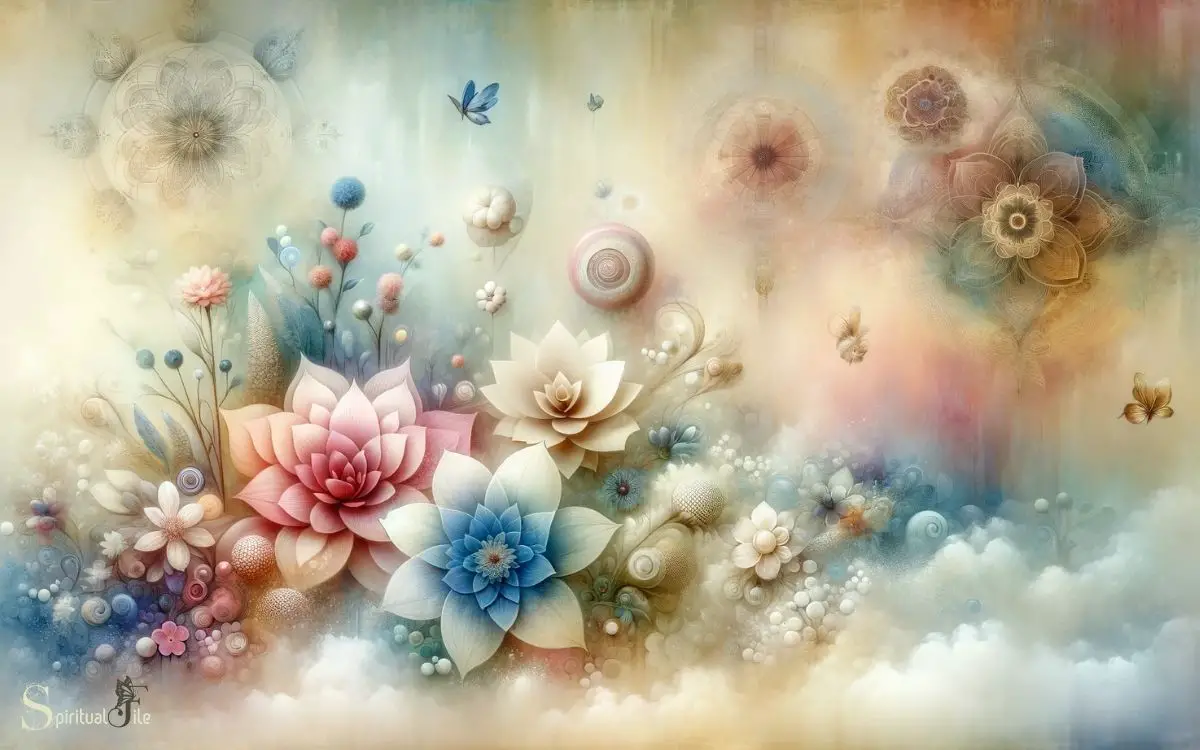What Do Flowers Symbolize Spiritually? Life!
Flowers hold diverse spiritual meanings across various cultures, often symbolizing life, growth, and purity. They can represent love, birth, unity, and the cycle of life and death.
Different flowers and their colors carry unique spiritual messages and are used in rituals, meditation, and as symbols of spiritual beliefs. The spiritual symbolism of flowers is deeply embedded in human culture and spirituality.
For instance, the lotus flower in Buddhism represents purity of the body, speech, and mind, as it emerges unblemished from murky waters. Similarly, the white lily is often associated with purity and the Virgin Mary in Christianity.
- Lotus: Purity, spiritual awakening in Buddhism
- White Lily: Purity, Virgin Mary in Christianity
- Rose: Love and passion in various cultures
Incorporating the spiritual essence of flowers into our lives can foster a deeper connection with nature and the divine, enriching our spiritual journey and daily practices.

Key Takeaway
The Historical Significance of Flower Symbolism
The historical significance of flower symbolism dates back centuries and has played a significant role in various cultures and traditions. Flowers have been used to convey messages, emotions, and meanings in different societies across the world.
- In ancient Egypt, for instance, lotus flowers symbolized rebirth and the sun.
- In Greek mythology, the narcissus flower represented vanity, while the iris symbolized communication.
- Similarly, in the Victorian era, floriography, or the language of flowers, was used to express feelings that could not be spoken aloud.
Understanding the historical context of flower symbolism provides insight into the cultural and social significance attached to different flowers.
This foundation is crucial for comprehending the spiritual meanings associated with specific flowers, which will be explored in the subsequent section.
The Spiritual Meaning of Specific Flowers
Specific flowers hold spiritual significance that transcends cultural boundaries and conveys profound symbolism.
For example, the lotus flower symbolizes purity and enlightenment in Hinduism and Buddhism, as it emerges from murky waters to bloom immaculately.
The rose is often associated with love and beauty, representing the heart chakra in spiritual practices.
In Native American traditions, the sage plant is revered for its cleansing properties, used in purification rituals to clear negative energies.
Additionally, the lily is a symbol of purity and rebirth in Christianity, often associated with the Virgin Mary.
Understanding the spiritual meanings of specific flowers allows individuals to incorporate these symbols into their spiritual practices, meditation, and rituals, deepening their connection to the divine and the natural world.
How Flowers Are Used in Spiritual Practices
Flowers have long been used in various spiritual practices, including as offerings in rituals and as aids in meditation.
Floral ritual offerings are a common practice in many spiritual traditions, symbolizing gratitude, reverence, and connection to the divine.
Additionally, sacred flower meditation involves using the energy and symbolism of specific flowers to enhance spiritual experiences and inner reflection.
Floral Ritual Offerings
Floral ritual offerings play a significant role in various spiritual practices, serving as symbolic gestures of reverence and devotion.
They are used in the following ways:
- Altar Offerings: Flowers are placed on altars as offerings to deities or spiritual figures, symbolizing gratitude, purity, and beauty.
- Ceremonial Decor: In rituals and ceremonies, flowers are used to adorn spaces, creating a sacred and peaceful atmosphere. Their presence is believed to invite positive energy and blessings.
- Sacred Cleansing: In some traditions, flowers are used in cleansing rituals to purify the mind, body, and spirit. The act of offering and receiving flowers is considered a form of spiritual cleansing and renewal.
Flowers hold deep spiritual significance in many cultures, and their use in ritual offerings is a tangible expression of faith and devotion.
Sacred Flower Meditation
In spiritual practices, the use of flowers in sacred meditation is a revered tradition that fosters contemplation and connection with the divine.
The practice of sacred flower meditation involves focusing on a specific flower, allowing its beauty and symbolism to guide the meditator towards spiritual awakening and inner peace.
Each flower is believed to hold unique energetic qualities that can aid in the journey of self-discovery and transcendence.
Meditators often choose flowers based on their spiritual significance, such as the lotus flower representing purity and enlightenment in various Eastern traditions.
By immersing oneself in the essence of a flower, individuals seek to harmonize their energy with the natural world and invoke a sense of reverence for the interconnectedness of all living beings.
Sacred flower meditation serves as a pathway to attaining higher states of consciousness and deepening one’s spiritual understanding.
Understanding the Symbolism of Flower Colors
Understanding the symbolism of flower colors offers insight into the deeper meaning behind different hues. Color meanings in flowers carry significant spiritual symbolism and are often tied to emotions and cultural beliefs.
Exploring the spiritual significance of colors and their symbolism across different cultures can provide a rich understanding of the messages conveyed by flowers.
Color Meanings in Flowers
What do the colors of flowers symbolize spiritually?
Understanding the symbolism of flower colors can provide insight into the deeper meanings associated with different hues.
Here are three key color meanings in flowers:
- Red: This vibrant color is often associated with passion, love, and strong emotions. In a spiritual context, red flowers can symbolize vitality, courage, and the life force.
- White: White flowers are often seen as symbols of purity, innocence, and spirituality. They can represent the divine, enlightenment, and the presence of higher powers.
- Yellow: The color yellow is often linked to joy, optimism, and positivity. In a spiritual sense, yellow flowers can symbolize spiritual growth, happiness, and the radiant energy of the sun.
Understanding the symbolic meanings of flower colors can add a deeper layer of significance to the act of giving or receiving flowers in various spiritual or meaningful contexts.
Spiritual Significance of Colors
The symbolic meanings of flower colors deepen our understanding of their spiritual significance through the interpretation of hues associated with vitality, purity, joy, and other spiritual qualities.
White flowers, such as lilies and lotuses, symbolize purity and spiritual growth, while red flowers like roses often represent love, passion, and the life force.
Yellow flowers, like sunflowers, convey positivity, enlightenment, and spiritual nourishment. Blue flowers, such as forget-me-nots, embody tranquility, peace, and spiritual awakening.
Each color holds its own spiritual significance, adding depth to the symbolism of flowers in various spiritual practices and traditions.
Understanding the spiritual significance of flower colors provides a meaningful perspective on the messages and energies conveyed through these natural wonders.
Transitioning to the subsequent section, exploring the symbolism across different cultures further enriches our appreciation for the spiritual significance of flowers.
Symbolism Across Different Cultures
Symbolism of flower colors varies across cultures, reflecting diverse spiritual interpretations and traditions.
Understanding the symbolism of flower colors in different cultures can provide insight into the significance of these colors in spiritual practices.
Here are a few examples:
- Red: In many Asian cultures, red flowers symbolize good luck, joy, and happiness. In Hinduism, red is associated with passion and love, while in Western cultures, it often signifies romance and intensity.
- White: In some Eastern cultures, white flowers represent purity, spirituality, and mourning. In contrast, white flowers in Western cultures are often seen as symbols of innocence and purity.
- Yellow: In Eastern cultures, yellow flowers symbolize happiness, friendship, and positive energy. However, in some Western cultures, yellow flowers can represent jealousy or betrayal.
Understanding the cultural variations in flower color symbolism can deepen our appreciation for the spiritual significance of flowers.
Now, let’s delve into the ways in which people connect with nature through flower symbolism.
Connecting With Nature Through Flower Symbolism
Connecting with nature through flower symbolism offers individuals a profound spiritual connection to the natural world.
Flowers have long been used as symbols in various spiritual and religious practices, representing growth, transformation, and the interconnectedness of all living things.
By understanding the symbolism of different flowers, individuals can deepen their appreciation for the beauty and significance of the natural world.
This connection allows for a sense of harmony and mindfulness, fostering a greater awareness of the environment and the cyclical nature of life.
Whether it’s the resilience symbolized by a lotus flower or the purity represented by a white lily, each flower holds its own spiritual significance.
Embracing these symbols can provide a sense of peace and interconnectedness with nature, enhancing one’s spiritual journey.
Incorporating flower symbolism into daily life can profoundly impact one’s spiritual connection with the natural world.
What Flower Symbolizes Spirituality
The lotus flower is often considered a symbol of spirituality in various cultures and religions, including Buddhism and Hinduism.
The lotus is known for its ability to grow and bloom in muddy or murky water, yet it emerges from the water clean and pure. This characteristic has led to its association with spiritual growth, enlightenment, and purity.
In Buddhism, the lotus flower is particularly significant. It represents the journey from ignorance and suffering (symbolized by the muddy water) to enlightenment and purity (symbolized by the blossoming lotus). The lotus is often used as a symbol of enlightenment and spiritual awakening.
In Hinduism, the lotus is associated with various deities and is considered a symbol of beauty, prosperity, and spiritual growth.
It is often depicted in religious art and is also associated with the chakras, with each petal of the lotus representing a different aspect of spiritual consciousness.
So, if you’re looking for a flower that symbolizes spirituality, the lotus is a meaningful choice that has deep spiritual significance in several traditions.
How Do Different Symbols Carry Spiritual Meanings?
Symbols possess a profound ability to convey spiritual meanings, and the spiritual meaning of rainbows is no exception. Rainbows have long been regarded as mystical and divine, representing hope, transformation, and bridging the gap between earthly and celestial realms. The vibrant colors harmoniously blending together symbolize unity, diversity, and the beauty of life’s countless facets. Rainbows serve as reminders of the interconnectedness and spiritual journey we all embark upon.
Incorporating Flower Symbolism Into Daily Life
Incorporating flower symbolism into daily life fosters a deeper spiritual connection with the natural world, encouraging mindfulness and harmony.
Here are three ways to bring flower symbolism into your daily routine:
- Meditation and Reflection: Start your day by meditating on the symbolic meanings of different flowers. Reflect on their qualities and how they can be integrated into your life for personal growth and spiritual development.
- Floral Decor: Incorporate flowers that hold spiritual significance into your living or working space. Surrounding yourself with these blooms can serve as a visual reminder of the deeper meanings they represent.
- Mindful Flower Practices: Engage in activities such as flower arranging, gardening, or simply taking leisurely walks in nature. These practices can help you connect with the spiritual essence of flowers and the natural world, fostering a sense of peace and balance in your daily life.
Conclusion
The symbolism of flowers holds a rich historical significance and spiritual meaning. Understanding the symbolism of specific flowers and their colors can enhance spiritual practices and help individuals connect with nature.
Incorporating flower symbolism into daily life can bring a sense of peace and harmony. The power of flower symbolism is truly extraordinary and can transform the way we perceive the world around us.






